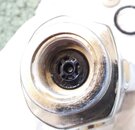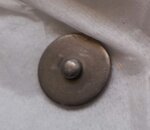aoumi
Registered
Just finished overhauling my MK21, all went smoothly with 1 exception. I understand the MK25 and MK21 seat and seat retainer configuration are the same.
What happened, is that the plastic seat (part no 10.101.161), has sitting on top of it a metal 'spacer' with a dimple on it (part no 10.752.102). The dimple simply fits into the back of the plastic seat, there is a hole on the seat to receive it.
However, when I installed the new seat, the spacer didn't seem to just sit on top of the seat, the dimple wouldn't insert into the seat. (The old one just sat on top, no force required to install it, and fell out on its own when dis-assembling).
I tried pushing the spacer with dimple into the seat, but it didn't seem to want to fit, or perhaps it actually WAS sitting flat on the seat - it was hard to tell with it installed in reg body, so I continued with assembly.
When it came to to adjust the IP (after reassembly was completed), the adjustment screw, during installation, was installed backed all the way out, so needed screwing in before the the regulator is able to hold an acceptable IP. So I started screwing it in with the allen key while the reg was de-pressurised. It screwed in a bit, then met some resistance.
So, I turned on the air very slowly (with IP gauge and 2nd stage attached), and the reg was going over 150 psi even though resistance had been met with the screw. So, I again de-pressurised it, and slowly screwed in some more - this time against the resistance. The resistance held for maybe 1/3 of a turn of the screw, then reduced back to nothing at all. After this, turned on the air again, and this time the reg held an IP closer to acceptable, on the high side, but I was able to de-pressurize it again and screw in the adjustment screw more (a little each time before checking the IP), and eventually set a stable 135 IP. It locks up ok, and doesn't creep.
My assumption is, that I had to turn the adjustment screw in, in order to press the dimple of the spacer into the seat. Is this normal? Or was there a bad batch of seats that were manufactured a while back with the incorrect size hole to receive the dimple? Maybe this is perfectly normal, but wanted to see what the experts here say. It seems to be not what I would have expected.
Here is a picture during dis-assembly of seat:

and the spacer:

What happened, is that the plastic seat (part no 10.101.161), has sitting on top of it a metal 'spacer' with a dimple on it (part no 10.752.102). The dimple simply fits into the back of the plastic seat, there is a hole on the seat to receive it.
However, when I installed the new seat, the spacer didn't seem to just sit on top of the seat, the dimple wouldn't insert into the seat. (The old one just sat on top, no force required to install it, and fell out on its own when dis-assembling).
I tried pushing the spacer with dimple into the seat, but it didn't seem to want to fit, or perhaps it actually WAS sitting flat on the seat - it was hard to tell with it installed in reg body, so I continued with assembly.
When it came to to adjust the IP (after reassembly was completed), the adjustment screw, during installation, was installed backed all the way out, so needed screwing in before the the regulator is able to hold an acceptable IP. So I started screwing it in with the allen key while the reg was de-pressurised. It screwed in a bit, then met some resistance.
So, I turned on the air very slowly (with IP gauge and 2nd stage attached), and the reg was going over 150 psi even though resistance had been met with the screw. So, I again de-pressurised it, and slowly screwed in some more - this time against the resistance. The resistance held for maybe 1/3 of a turn of the screw, then reduced back to nothing at all. After this, turned on the air again, and this time the reg held an IP closer to acceptable, on the high side, but I was able to de-pressurize it again and screw in the adjustment screw more (a little each time before checking the IP), and eventually set a stable 135 IP. It locks up ok, and doesn't creep.
My assumption is, that I had to turn the adjustment screw in, in order to press the dimple of the spacer into the seat. Is this normal? Or was there a bad batch of seats that were manufactured a while back with the incorrect size hole to receive the dimple? Maybe this is perfectly normal, but wanted to see what the experts here say. It seems to be not what I would have expected.
Here is a picture during dis-assembly of seat:

and the spacer:




